Mr WRH Martin (Bill to his colleagues and Froggy to the boys), who was for many years the driving force of Mount Albert Grammar School soccer, reported on the
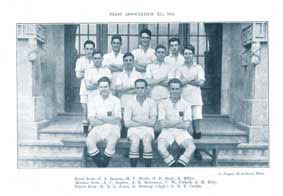 beginnings of the game.
beginnings of the game.
“Early in 1924 R. Broberg, C.P.C. Shea and N.B. Bach [N.D. Bach] approached the Headmaster for permission to enter teams in the Auckland Football Association competitions. They did so with some trepidation, for an earlier request had been declined.”1
After the boys had assured the Headmaster that the game would cater for a significant number of boys, Mr Gamble acquiesced.
Broberg was the captain of the first, First XI, Bach was one of the halfbacks and Shea did not play but as he was a cricketer (Mr Gamble’s favourite sport) and a prefect, he may have been taken along for moral support.
The Albertian of that year reported:
“The beginning of the 1924 football season saw the introduction of Association into the School. Boys who had previously been playing for outside clubs now had the opportunity of combining and playing for their School.
“The matter was earnestly taken in hand, and in a short time four teams were formed and entered for competition in the various grades. The 1st XI. played in the Fourth Grade A, the 2nd XI. in the Fifth Grade A, the 3rd XI. in the Fifth Grade B, and the 4th XI. In the Sixth Grade.”2
The First XI played 10 games in two rounds against five clubs; Y.M.C.A., North Shore, Brotherhood, Belmont and Ponsonby. They won 4, drew 3 and lost 3.
In 1925 there was an “uphill fight”3 since school teams were not formed until late in the year when many of the better players were playing for clubs, “‘ the First XI., however, had special tuition with Mr Blaiklock, and the other Elevens are all looking forward to the time when they will receive special coaching.”4
Despite the late start the team played at least 15 matches, won 6, drew 2 and lost 7 and they had 29 goals for and 28 against. They played against Northcote, Belmont, Comrades, North Shore, Richmond, Kowhai and Carlton.
In 1926 The Albertian reported that:
“Association was continued this year in the school and prospered exceedingly.”
The first competition was won that year. The 3rd XI playing in the AFA Fifth Grade B, won 12 of their 17 games and scored 29 goals for and had 11 scored against them. There was another first too: “The goal posts erected in the second term have proved a boon to us, as dinner-time practice can now be indulged in and the time may yet come when the soccerites will play matches on the school ground.”6 1927 saw the formation of the Auckland Secondary Schools’ Competition and the School entered three teams and two more in the Auckland Football Association Competitions. The Albertian featured a graphic heading to the notes and went on to say: “The past season has been a flourishing one for ‘Soccer’ enthusiasts ‘ for the first time this year the School
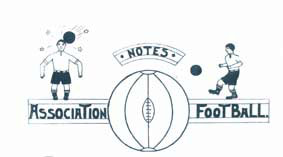 Association XI. was given the privilege of wearing the school stockings ‘”7
Association XI. was given the privilege of wearing the school stockings ‘”7
The School won this inaugural competition, playing two rounds against Seddon Memorial Technical College A, B and C teams, St Stephen’s College and our own Second XI. We are now the only surviving school of that first year. The First XI won the competition for the next four years.
In 1928 Auckland Grammar School entered a team for the first time and the SMTC third team dropped out. That year also saw the first The Albertian mention of the Knock-out Competition ‘ which the School won ‘ and the photograph of the team showed the Beswick Shied for the first time. (Mr RM Beswick had been a prime mover in establishing the Secondary Schools’ Competition). It was a vintage year for the senior team winning two games by 20-0 and one by 16-0 with 69 goals for and only 6 against. The Headmaster noted in his annual report. “The Rugby group by losing their championship only in the playoffs with King’s College received fullest sympathy from
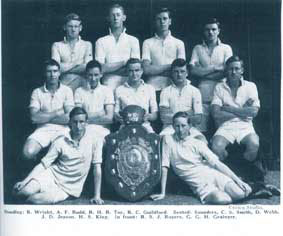 the Association group whose XI. gained championship honours ‘”8
the Association group whose XI. gained championship honours ‘”8
Winning was not Mr Gamble’s focus, his concern was; “‘ the steady growth among the boys of those virtues of comradeship and sportsmanship for the encouragement of which the playing fields afford golden opportunities.” 9 The following year, 1929, saw the establishment of an Intermediate grade. The School’s A team won both the championship and the knock-out competition.
Lions were awarded for the first time to the 1930 team. Also that year “The first of the annual games against the Old Boys resulted in a draw; the discussion after the game brought a decision to form an Old Boys’ Association Football Club”10.
A meeting of the Old Boys’ Association committee recorded that: “Messrs Webb and Hely were mentioned as two likely members to arrange and select a soccer team.”11
By the next year it was a done deal:
“Before the commencement of the football season enthusiastic Old Boys met at the Y.M.C.A. where it was resolved to form an Old Boys’ Association Football Club.”12
Mr Butler, President of the MAGSOBA and Mr Martin, MIC Association Football gave assurances that both the Old Boys and the School supported the venture. A Club Committee was elected; two teams were fielded in the Auckland FA competitions and the year ended with a knees-up. “On the evening of Saturday October 3, a very successful dance, held in the Lewis Eady Hall concluded the season’s activities.”13
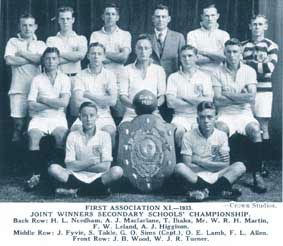 The School also had a famously good year. An Auckland Secondary Schools’ representative team playing in Wellington had no fewer than seven of the School’s players.
The School also had a famously good year. An Auckland Secondary Schools’ representative team playing in Wellington had no fewer than seven of the School’s players.
1932 was the first year the team did not win the Championship and it was also the first year that the redoubtable Mr Martin took his place in the team photograph.
From 1933 to 1938 there was a six-year run of championship wins. (This has been surpassed only by the Rowing XIII’s seven-year hold on the Head of the Harbour from 1940 ‘ 1946).
Mr Martin reported that:
“In 1937 all six competitions, championship and Knock-out were won by School teams. This year several members of the touring English XI. visited the School and played with the boys of the School against an Old Boys’ team, coaching them during the play. It was an inspiring occasion.”14
In 1938 a New Zealand Secondary Schools’ Association Football team toured Australia. The co-manager was Mr WRH Martin and all the Auckland members came from our School; EF Boddy, HJH Irving, EG McLachlan and DD Taylor. They won every game. A newspaper report of the time claimed that DD Taylor could fill any defensive position with distinction. He went on to be a noted cricketer ‘ playing three tests for New Zealand.
Of the 12 members of the 1933 team in that year’s photograph, six of them; F Fyvie, AJ Higgison, OE Lamb, FW Leland, AJ Macfarlane and JB Wood joined the Air Force in the Second World War. All were killed on active service. Five of them had been members of the Old Boys’ Club, which had gone from strength to strength. Fyvie was an outstanding player and his father was a Vice-President of the Club. Another father, Mr GS Coldam made a fateful reference to “the outstanding worth to the cub of J Fyvie, Junr., who had joined the Air Force”.15 A year later Fyvie was dead and the year after that Mr Coldham’s own son ‘ also in the Air Force ‘ was dead.
By 1942, 30 members of the club had joined the forces, yet the club could still field three teams, going up to five in 1946, six in 1948 (when the Club had eight trophies) and in 1950 it fielded eight teams and three of them won their championships ‘ all without loss of a game.
However, like the Old Boys’ Athletic Club, the Old Boys’ Cricket Club and the Albertian Hockey Club (all of which had had considerable success during their lifetimes), the Old Boys’ Association Football Club, as an independent entity, was no longer reported on after 1952.
Parallelling the Club’s earlier success was the continued extraordinary performance by the School’s teams. There was a period of seven championship wins in 10 years; beginning in 1944 when the team won all 13 games and scored 56 goals and had none scored against them. This was followed by wins in 1945, 1946, 1947, 1949, 1950 and
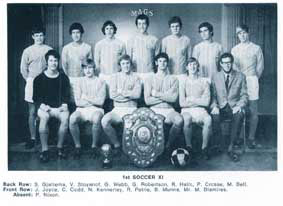 1952. Also during this decade at least 75 other teams were fielded.
1952. Also during this decade at least 75 other teams were fielded.
In the School’s first quarter century there were five Internationals: FS Blackie (1933), JD Jepson (1936-7), HD Hutchinson (1946-7) and A Wilkinson (1946). An in the sixties there were two new Internationals; JG Kemp (1960-2 and 1964) and RJ Cochran (1964).
The Senior A team won again in 1955, 1956, 1958, 1961 and 1962. In 1963 the team was joint champions with Auckland Grammar School (as they had been in 1933) and in 1964 joint champions with Mount Roskill Grammar School. We won again in 1968.
In 1970 the First XI played 24 games and had 24 wins. “The season proved to be one of the most successful the School has experienced. The First XI won the Auckland Championship. The Senior C championship was won and the Intermediate A won their competition without conceding one goal throughout the season. In addition, the First XI won the New Zealand Secondary Schools tournament.”16 In 1971 we were again Auckland Champions and the School hosted the New Zealand Secondary Schools’
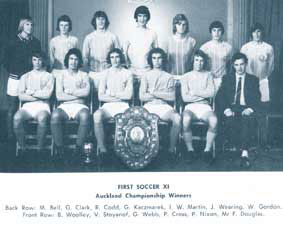 Soccer Tournament (won by Wellington College).
Soccer Tournament (won by Wellington College).
1975 was in some ways a swan song. We were Auckland Champions and were beaten into second place at the New Zealand Tournament by Rangotai College.
Then followed 23 years of locusts and wild honey until the arrival of Kevin Fallon in 1997 gave a new glimpse of the promised land. In that year the team was runner-up in the Premier League, the Knock-out Cup and the New Zealand Secondary Schools’ Tournament.
More success came in 1998; the team won both the championship and the Knock-out. David Mulligan and Rory Fallon signed contracts with English First Division club, Barnsley. Rory Fallon went on to play for England under 17. Nine players were selected for the New Zealand under 16 team, which toured Germany and France. Stephen Morrell went on to play for Fiji and Jerry Allen played for the Solomon Islands.
The 1999 team completed the trifecta; Auckland champions, Knock-out Cup winners and New Zealand champions. In the 14 games of the Auckland Premier League the team scored 96 goals and had 5 scored against them. They were, of course, unbeaten in the Knock-out Cup and also in the National tournament. The captain, Jeremy Christie became Captain of the New Zealand under 17 team to play in the FIFA under 17 Word Cup played in Auckland. Tony Lochhead was Vice-Captain and 10, yes 10! other first XI squad members were in the National team; Karl Bugden, John Fergusson, Julius Kolk, Allan Pearce, Simon Perez, Naveen Prasad, David Raynor, Matthew Silver, Sinjay Singh and Daniel Trent.
1999 was a vintage year all round. There were four other teams entered in competitions; the 2nd XI, 15A and 13A won their championships and the 14A were runners-up. There were Auckland Secondary Schools’ representatives at every level.
The 2000 team again won the Knock-out Cup and were second in Auckland and in New Zealand. They also played the Samoan national team and won 4-2. The notable feature of the year was the formation of a junior girls’ team in the first year of the Girls’ School. They reached their divisional final losing a close encounter to Epsom Girls’ Grammar School despite being a year younger.
The boys’ 2001 team was Auckland Champion and New Zealand Champion and it reached the last 16 of the Chatham Cup. (The team was first entered in 1999 and progressed to the third round).
We had an historical year in 2002; for the first time we had a girls’ team playing in a senior competition and the Premier grade at that. They went on to play at the Tauranga Satellite Tournament where they reached the semi-final. The boys’ team won the Knock-out Cup.
Five of the six boys’ teams of 2003 played in the Premier grades and four of them won their championships. The First XI were runners up in Auckland but went on to be once again New Zealand champions.
The girls’ First XI had an outstanding year. They reached the final of the Auckland Provincial Championship and qualified for the New Zealand Secondary Schools’ Girls’
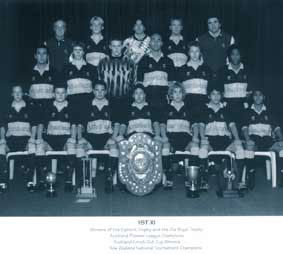 National Soccer Tournament in Cambridge where they finished fourth and automatically qualify for the 2004 tournament in Christchurch. They are beginning to emulate their elder brothers.
National Soccer Tournament in Cambridge where they finished fourth and automatically qualify for the 2004 tournament in Christchurch. They are beginning to emulate their elder brothers.
To be New Zealand Boys’ Champions four times (three in five years) and to win the Auckland Championships 32 times in 77 years is a record of which any school could be proud. And there’s more to come in the years ahead.
As we look back on the photograph of the 1924 team who started it all we see looking back at us confident looking boys on the brink of manhood, boys who were just in primary school as Archduke Ferdinand was taking a bullet in Sarajevo and all that flowed from that, boys who survived the influenza pandemic of 1918 and the local outbreak of typhoid fever of 1922, boys who were enjoying a brief period of tranquillity before the Great Depression of the early thirties and long shadow of war of the late thirties when they would have been of an age to be called up to put a stop to Hitler. Yet they endured. They have lessons for the players of today.
Brian Murphy, Archivist
References:
1 WRH Martin, in Mount Albert Grammar School: Silver JubileeSouvenir, p26-28, ed. JH Harvey, Auckland 1946.
2 GET Carder, in The Albertian, 1924, pp 82-83.
3 WA Penton, in The Albertian, 1925, pp 5-59.
4 WA Penton, loc. cit.
5 WA Penton, in The Albertian, 1926, p77.
6 WA Penton, loc. cit.
7 Unattributed, The Albertian, 1927, p93.
8 FW Gamble, Headmaster’s Report, in Mount Albert Grammar School: School List, 1928, pp18-24.
9 FW Gamble, loc.cit
10 JG Brown, ed. Mount Albert Grammar School: Golden Jubilee,1922-1971, p187, Auckland 1971.
11 Minutes of the Mount Albert Grammar School Old Boys’ Association, Vol 2, 24 July 1930.
12 Unattributed, The Albertian, 1931, pp 30-31.
13 The Albertian, 1931, loc.cit.
14 WRH Martin, loc.cit
15 Unattributed, The Albertian, 1941, pp38-39.
16 MD Nairn, Headmaster’s Report for 1970
